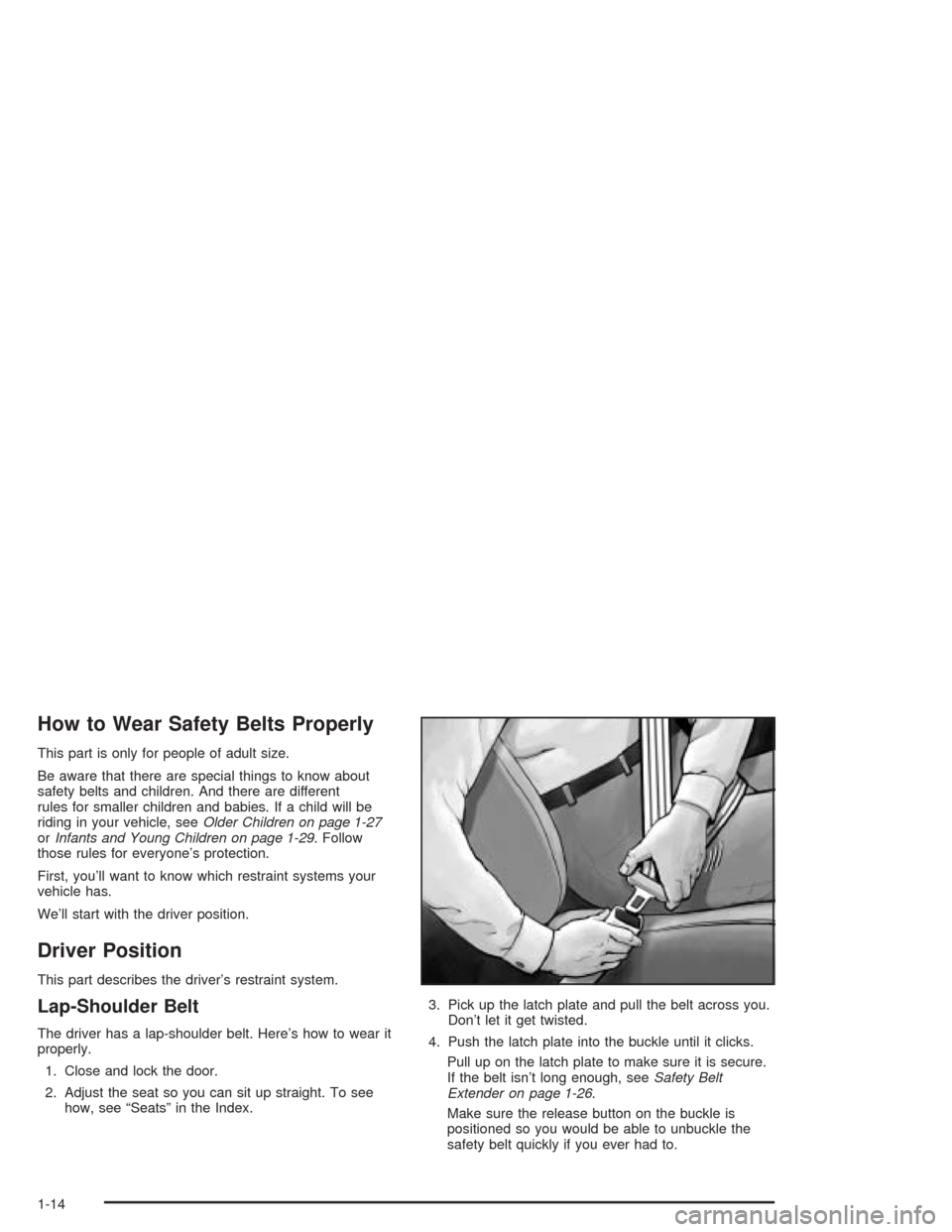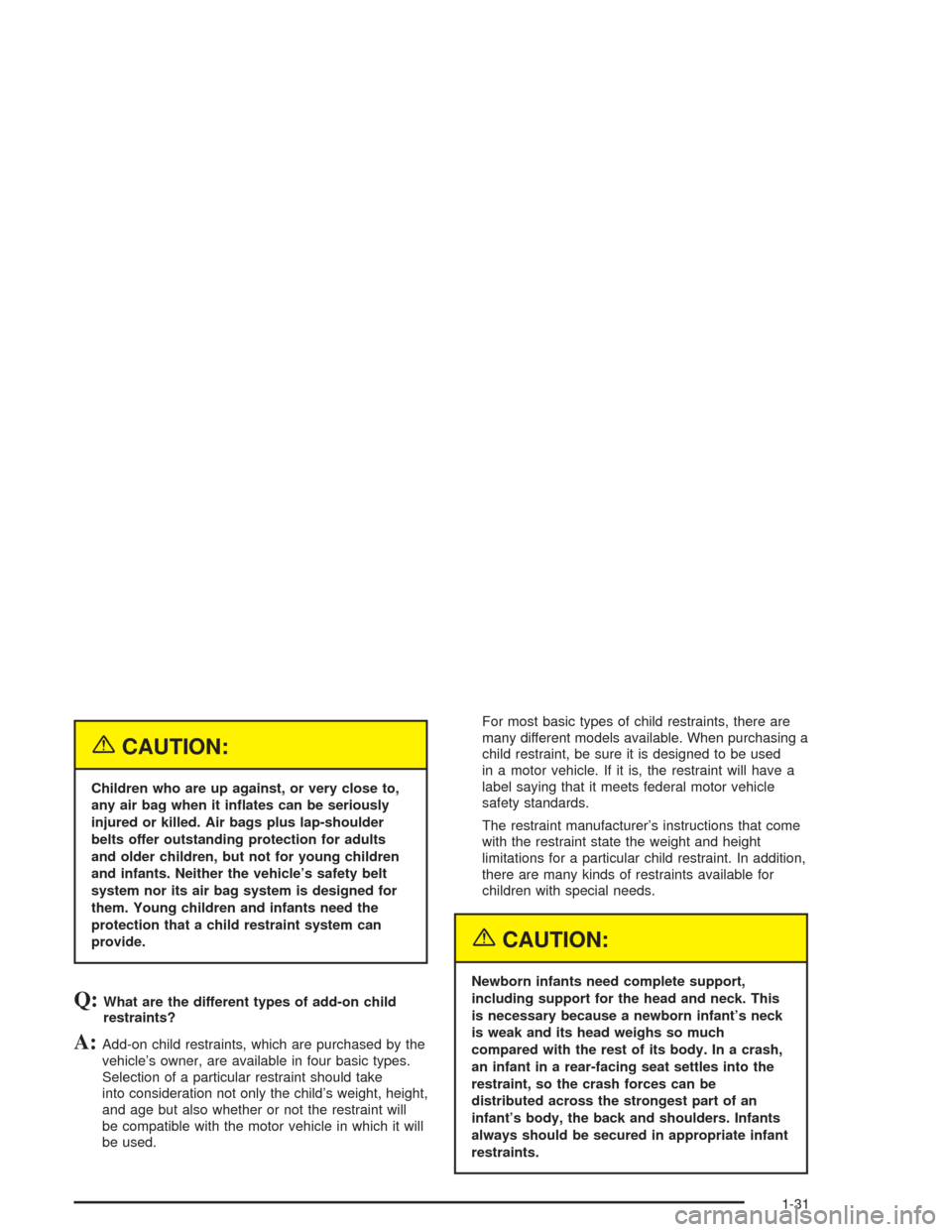Page 7 of 448

Front Seats......................................................1-2
Manual Seats................................................1-2
Power Seats..................................................1-2
Manual Lumbar..............................................1-3
Power Lumbar...............................................1-3
Heated Seats.................................................1-3
Reclining Seatbacks........................................1-4
Head Restraints.............................................1-5
Rear Seats.......................................................1-6
Rear Seat Operation.......................................1-6
Safety Belts.....................................................1-8
Safety Belts: They Are for Everyone.................1-8
Questions and Answers About Safety Belts......1-13
How to Wear Safety Belts Properly.................1-14
Driver Position..............................................1-14
Safety Belt Use During Pregnancy..................1-20
Right Front Passenger Position.......................1-21
Rear Seat Passengers..................................1-21
Rear Safety Belt Comfort Guides for
Children and Small Adults..........................1-24
Safety Belt Extender.....................................1-26
Child Restraints.............................................1-27
Older Children..............................................1-27
Infants and Young Children............................1-29
Child Restraint Systems.................................1-32Where to Put the Restraint.............................1-35
Top Strap....................................................1-36
Top Strap Anchor Location.............................1-37
Lower Anchorages and Top Tethers for
Children (LATCH System)...........................1-38
Securing a Child Restraint Designed for
the LATCH System....................................1-40
Securing a Child Restraint in a Rear
Outside Seat Position................................1-41
Securing a Child Restraint in the Center
Seat Position............................................1-44
Securing a Child Restraint in the Right
Front Seat Position....................................1-44
Air Bag Systems............................................1-47
Where Are the Air Bags?...............................1-50
When Should an Air Bag In�ate?....................1-52
What Makes an Air Bag In�ate?.....................1-53
How Does an Air Bag Restrain?.....................1-54
What Will You See After an Air
Bag In�ates?............................................1-54
Servicing Your Air Bag-Equipped Vehicle.........1-56
Restraint System Check..................................1-56
Checking Your Restraint Systems...................1-56
Replacing Restraint System Parts
After a Crash............................................1-57
Section 1 Seats and Restraint Systems
1-1
Page 12 of 448
Rear Seats
Rear Seat Operation
Your vehicle may have a folding rear seat which lets
you fold the seatbacks down for more cargo space.
Pull up on the loop located where the seat cushion
meets the seatback to fold the seat cushion up and out
of the way. This will allow the seatback to fold �at
and increase the cargo area.The rear seatback
levers are located on the
outboard side of
the rear seatbacks.
Pull the seatback toward you as you lift up on the lever.
The head restraint will automatically fold out of the
way when the seatback is folded down.
To raise the seatbacks, lift up the seatbacks and push
on them until they lock into the upright position.
Push and pull on the seatbacks to make sure that they
are latched securely. Then fold the bottom seat
cushion back into place.
1-6
Page 13 of 448
To return the head restraint to the upright position,
reach behind the seat and pull the restraint up until it
locks into place. Push and pull on the head restraint to
make sure that it is latched securely.
Rear Seats (TrailBlazer EXT)
The second row seat is a 65/35 split seat which may be
folded and tumbled. Use this feature for gaining
access to the third row seats.To fold and tumble the second row seat(s), do the
following:
1. Push the head restraints fully down.
2. Fold the seatback �at on the seat by pulling up on
the front part of the fold and tumble lever. The lever
is located on the outboard side of the seat
(indicated as 1 on the handle side cover).
3. Release the rear set of seat hooks from the �oor
pins by pulling up on the rear part of the lever
(indicated as 2 on the handle side cover). This
enables the seat to be tumbled forward.
1-7
Page 20 of 448

How to Wear Safety Belts Properly
This part is only for people of adult size.
Be aware that there are special things to know about
safety belts and children. And there are different
rules for smaller children and babies. If a child will be
riding in your vehicle, seeOlder Children on page 1-27
orInfants and Young Children on page 1-29. Follow
those rules for everyone’s protection.
First, you’ll want to know which restraint systems your
vehicle has.
We’ll start with the driver position.
Driver Position
This part describes the driver’s restraint system.
Lap-Shoulder Belt
The driver has a lap-shoulder belt. Here’s how to wear it
properly.
1. Close and lock the door.
2. Adjust the seat so you can sit up straight. To see
how, see “Seats” in the Index.3. Pick up the latch plate and pull the belt across you.
Don’t let it get twisted.
4. Push the latch plate into the buckle until it clicks.
Pull up on the latch plate to make sure it is secure.
If the belt isn’t long enough, seeSafety Belt
Extender on page 1-26.
Make sure the release button on the buckle is
positioned so you would be able to unbuckle the
safety belt quickly if you ever had to.
1-14
Page 28 of 448
Lap-Shoulder Belt
All rear seating positions have lap-shoulder belts. Here
is how to wear one properly.
1. Pick up the latch plate and pull the belt across you.
Do not let it get twisted.
2. Push the latch plate into the buckle until it clicks.
Pull up on the latch plate to make sure it is secure.When the shoulder belt is pulled out all the way, it
will lock. If it does, let it go back all the way
and start again. If the belt is not long enough, see
Safety Belt Extender on page 1-26.
Make sure the release button on the buckle is
positioned so you would be able to unbuckle the
safety belt quickly if you ever had to.
3. To make the lap part tight, pull up on the
shoulder part.
1-22
Page 36 of 448
{CAUTION:
People should never hold a baby in their arms
while riding in a vehicle. A baby does not weigh
much -- until a crash. During a crash a baby will
become so heavy it is not possible to hold it.
CAUTION: (Continued)
CAUTION: (Continued)
For example, in a crash at only 25 mph
(40 km/h), a 12-lb. (5.5 kg) baby will suddenly
become a 240-lb. (110 kg) force on a person’s
arms. A baby should be secured in an
appropriate restraint.
1-30
Page 37 of 448

{CAUTION:
Children who are up against, or very close to,
any air bag when it in�ates can be seriously
injured or killed. Air bags plus lap-shoulder
belts offer outstanding protection for adults
and older children, but not for young children
and infants. Neither the vehicle’s safety belt
system nor its air bag system is designed for
them. Young children and infants need the
protection that a child restraint system can
provide.
Q:What are the different types of add-on child
restraints?
A:Add-on child restraints, which are purchased by the
vehicle’s owner, are available in four basic types.
Selection of a particular restraint should take
into consideration not only the child’s weight, height,
and age but also whether or not the restraint will
be compatible with the motor vehicle in which it will
be used.For most basic types of child restraints, there are
many different models available. When purchasing a
child restraint, be sure it is designed to be used
in a motor vehicle. If it is, the restraint will have a
label saying that it meets federal motor vehicle
safety standards.
The restraint manufacturer’s instructions that come
with the restraint state the weight and height
limitations for a particular child restraint. In addition,
there are many kinds of restraints available for
children with special needs.
{CAUTION:
Newborn infants need complete support,
including support for the head and neck. This
is necessary because a newborn infant’s neck
is weak and its head weighs so much
compared with the rest of its body. In a crash,
an infant in a rear-facing seat settles into the
restraint, so the crash forces can be
distributed across the strongest part of an
infant’s body, the back and shoulders. Infants
always should be secured in appropriate infant
restraints.
1-31
Page 38 of 448
{CAUTION:
The body structure of a young child is quite
unlike that of an adult or older child, for whom
the safety belts are designed. A young child’s
hip bones are still so small that the vehicle’s
regular safety belt may not remain low on the
hip bones, as it should. Instead, it may settle
up around the child’s abdomen. In a crash, the
belt would apply force on a body area that is
unprotected by any bony structure. This alone
could cause serious or fatal injuries. Young
children always should be secured in
appropriate child restraints.
Child Restraint Systems
An infant car bed (A), a special bed made for use in a
motor vehicle, is an infant restraint system designed
to restrain or position a child on a continuous �at
surface. Make sure that the infant’s head rests toward
the center of the vehicle.
1-32